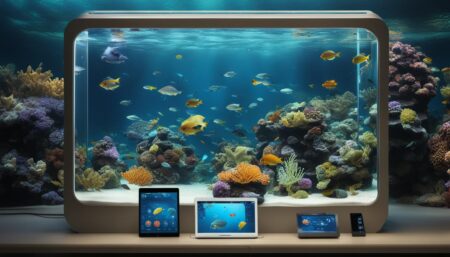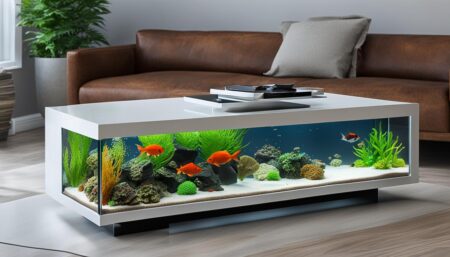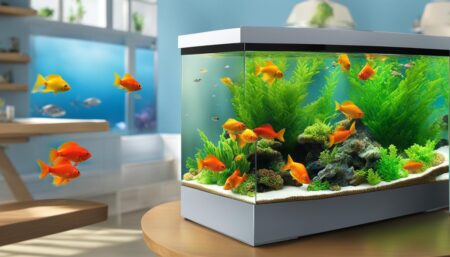In the ever-evolving world of technology, voice-controlled devices have become increasingly popular. From smart speakers to automated home systems, our daily lives are being transformed by the power of voice commands. And now, this advanced technology is extending its reach to a surprising domain – aquariums.
Imagine being able to interact with your aquarium simply by using your voice. No more fumbling with buttons or dials; just speak, and your aquarium responds. This is the future that voice-controlled aquariums promise, bringing a new level of convenience, interactivity, and innovation to fishkeeping enthusiasts.
Whether you’re a seasoned aquarium hobbyist or someone who has always been fascinated by marine life, voice-controlled aquariums offer a whole new way to immerse yourself in the underwater world. By using spoken commands or through mobile apps, you can now control and monitor your aquarium with ease.
Key Takeaways:
- Voice-controlled aquariums provide a unique and interactive experience for fishkeeping enthusiasts.
- Through spoken commands or mobile apps, users can easily control and monitor their aquariums.
- This technology offers convenience and innovation, making fishkeeping more accessible and enjoyable.
- Voice-controlled aquariums are a glimpse into the future of smart home ecosystems.
- With advancements in technology, we can expect even more exciting features and integration in the future.
The Benefits of Voice-Controlled Aquariums
Voice-controlled aquariums offer numerous benefits for both aquarium enthusiasts and aquatic pets. These innovative setups provide an immersive and interactive experience, allowing visitors to control and monitor their tanks through voice commands or mobile apps. With voice-activated tanks, aquarium owners can easily adjust settings, such as water temperature, lighting, and filtration, with a simple spoken command.
One of the key advantages of voice-controlled aquariums is the real-time monitoring of important parameters. These tanks use audio-responsive technology to track water conditions, including pH levels, oxygen levels, and temperature. This ensures optimal conditions for aquatic pets, promoting their health and well-being. Owners can also set up automated feeding systems, ensuring that fish are fed on a regular and precise schedule.
In addition to the benefits for aquatic pets, voice-controlled aquariums provide convenience and peace of mind for their owners. Notifications and alerts can be sent directly to the owner’s device if any parameter deviates from the desired range. This allows for prompt action to mitigate potential issues and ensures that aquariums are always in optimal condition. The integration of voice-controlled aquariums with smart home ecosystems further enhances their functionality, allowing users to seamlessly manage their tanks alongside other smart devices in their homes.

With the advancement of voice technology and the Internet of Things (IoT), voice-controlled aquariums are set to become even more sophisticated in the future. The ability to interact with aquariums through voice commands not only enhances the user experience but also creates a harmonious blend of technology and nature. As voice-controlled aquariums continue to evolve, aquarium enthusiasts can look forward to more advanced features and seamless integration with other smart devices in their homes.
The Integration of Voice-Controlled Aquariums with Smart Home Ecosystems
Voice-controlled aquariums have become increasingly popular among aquarium enthusiasts, offering a unique and interactive way to engage with marine life. These innovative setups allow users to control and monitor their tanks through voice commands or mobile apps, providing a seamless and convenient experience. But what makes voice-controlled aquariums even more appealing is their integration with smart home ecosystems.
By integrating voice-controlled aquariums with smart home ecosystems, owners can expand the functionalities of their tanks and create a connected and interactive environment. Imagine being able to adjust the lighting, temperature, and feeding schedule of your aquarium with a simple voice command or through an app on your phone. This integration adds a new level of convenience and ease of use, allowing users to manage their aquariums alongside other smart devices in their homes.
With the integration of voice-controlled aquariums into smart home ecosystems, the possibilities are endless. Owners can create custom voice commands to perform specific actions, such as feeding the fish, changing the water flow, or even playing soothing sounds for a calming effect. Additionally, the aquarium can be synchronized with other smart devices in the home, such as lighting systems, music players, or even virtual assistants like Amazon Alexa or Google Assistant.

Enhancing the Aquarium Experience
The integration of voice-controlled aquariums with smart home ecosystems not only adds convenience but also enhances the overall aquarium experience. With the ability to control and monitor the tank through voice commands or mobile apps, enthusiasts can easily maintain the optimal conditions for their aquatic pets. Real-time monitoring of parameters such as water temperature, pH levels, oxygen levels, and lighting conditions ensures that the aquarium environment remains stable and conducive to the health and well-being of the fish.
Creating a Connected Environment
A voice-controlled aquarium integrated with a smart home ecosystem allows users to seamlessly manage their aquarium alongside other smart devices. Imagine being able to create a synchronized experience in your living space, where the lighting, music, and ambiance of the room change based on the activities happening in the aquarium. This level of integration creates a harmonious blend of technology and nature, making the aquarium a centerpiece of the connected environment.
The Role of IoT in Smart Fish Aquariums
The Internet of Things (IoT) has had a significant impact on various industries, and the world of aquariums is no exception. IoT technology has revolutionized how we manage and monitor aquarium environments, giving rise to a new generation of smart fish aquariums. These aquariums leverage connected devices and sensors to create a seamless and enhanced user experience.
With IoT-based smart fish aquariums, monitoring and controlling crucial parameters such as water quality, temperature, and feeding schedules has become more efficient and convenient. Sensors placed in the aquarium constantly collect real-time data and transmit it to a central hub or mobile application, allowing aquarium owners to remotely monitor their tanks and make necessary adjustments.
Beyond just monitoring, IoT technology enables automated processes in smart fish aquariums. For example, automated feeding systems can be incorporated, ensuring that aquatic pets are fed on a regular and precise schedule. Owners can also receive notifications and alerts on their devices if any parameter deviates from the desired range, enabling them to take immediate action and prevent potential issues.
By integrating IoT capabilities, smart fish aquariums provide a seamless and connected environment for both novice and experienced aquarium enthusiasts. Through the power of voice-controlled commands or mobile apps, owners can easily manage their tanks and ensure optimal conditions for their aquatic pets.

Table: Comparison between Traditional and IoT-based Smart Fish Aquariums
| Features | Traditional Aquariums | IoT-based Smart Fish Aquariums |
|---|---|---|
| Monitoring Parameters | Manual, occasional checks | Real-time, continuous monitoring |
| Feeding | Manual, irregular feeding | Automated, regular and precise feeding schedules |
| Notifications and Alerts | No notifications | Instant notifications if parameters deviate from desired range |
| Connectivity | N/A | Connected to central hub or mobile application |
As shown in the comparison table, IoT-based smart fish aquariums provide significant advantages over traditional aquarium setups. With real-time monitoring, automated feeding, and instant notifications, owners can ensure the well-being of their aquatic pets more effectively. The integration of IoT technology creates a convenient and connected ecosystem that enhances the overall aquarium experience.
Benefits of IoT-Based Smart Fish Aquariums
Voice-controlled aquariums have revolutionized the way we interact with our aquatic pets. With the integration of IoT technology, these aquariums have become even more advanced and offer a multitude of benefits for both owners and their fish. Let’s explore the advantages of IoT-based smart fish aquariums.
One of the key benefits of IoT-based smart fish aquariums is the ability to ensure optimal conditions for aquatic pets. Through connected devices and sensors, these aquariums can monitor crucial parameters such as water temperature, pH levels, oxygen levels, and lighting conditions in real-time. This data is then transmitted to a central hub or mobile application, allowing owners to remotely monitor and manage their tanks. With this level of control, owners can make precise adjustments to create the perfect environment for their fish.
Automated feeding systems are another advantage of IoT-based smart fish aquariums. These systems can be integrated into the aquarium setup, ensuring regular and precise feeding schedules for the fish. Owners can set feeding times and portion sizes, providing a consistent and balanced diet for their aquatic pets. In addition, notifications and alerts can be sent to the owner’s device if any parameter deviates from the desired range. This allows for prompt action to be taken to mitigate potential issues and ensure the health and well-being of the fish.
| Benefits of IoT-Based Smart Fish Aquariums |
|---|
| Optimal conditions for aquatic pets |
| Real-time monitoring and control of parameters |
| Automated feeding systems |
| Notifications and alerts for parameter deviations |
Integration with voice assistants and smart home ecosystems is an additional benefit of IoT-based smart fish aquariums. Owners can control and monitor their aquariums through voice commands or mobile apps, making it convenient and user-friendly. The seamless integration with other smart devices in the home creates a connected and interactive environment, enhancing the overall experience for both the owners and their aquatic pets.
As technology continues to advance, we can expect even more innovative features and seamless integration in the future of voice-controlled aquariums. IoT-based smart fish aquariums provide a glimpse into the possibilities of this evolving technology, offering a harmonious blend of nature and technology to create captivating aquatic experiences.

Challenges of Implementing IoT-Based Smart Fish Aquariums
Implementing IoT-based smart fish aquariums presents several challenges that need to be addressed for a seamless user experience. One of the key challenges is ensuring reliable connectivity. Stable and uninterrupted internet access is crucial for real-time monitoring and control of the aquarium environment. A weak or unstable connection can disrupt the functionality of the IoT devices and hinder their ability to transmit data effectively.
Data security is another significant challenge when it comes to IoT-based aquariums. As these systems collect and transmit sensitive information about the aquarium’s parameters and the user’s preferences, it is crucial to implement robust security measures to protect against unauthorized access or data breaches. Encryption technologies and secure authentication protocols can help safeguard the data and ensure the privacy of the aquarium owner.
Another challenge is ensuring the reliability of the system. IoT-based smart fish aquariums rely on sensors, connected devices, and automation to monitor and control various parameters. It is essential to ensure that these components are functioning correctly and can withstand the demands of continuous operation. Regular maintenance, testing, and backup systems can help prevent any system failures or downtime, ensuring the consistent monitoring and management of the aquarium environment.
In conclusion, while IoT-based smart fish aquariums offer numerous benefits, such as optimal conditions for aquatic pets and automated control, there are challenges that need to be overcome. Reliable connectivity, data security, and system reliability are key considerations when implementing these systems. Addressing these challenges will ensure a seamless and secure user experience, enhancing the overall enjoyment and convenience of voice-controlled and IoT-enabled aquariums.

The Prototype and Analysis of IoT-Based Smart Fish Aquariums
Various studies have presented prototypes and analyses of IoT-based smart fish aquariums, showcasing the potential of this technology to transform the way we interact with aquatic environments. These prototypes utilize sensors to monitor crucial parameters such as water quality, temperature, and feeding schedules. By collecting real-time data from these sensors, the aquarium systems can make automatic adjustments to maintain optimal conditions for the fish.
One notable aspect of IoT-based smart fish aquariums is the integration of machine learning algorithms. These algorithms can analyze the collected data and predict future changes in water quality, enabling the system to make necessary alterations in settings to ensure a healthy and stable environment for the fish. This predictive capability adds an extra layer of control and care, enhancing the overall well-being of the aquatic pets.
“With IoT technology, we can now create smart fish aquariums that not only provide a visually appealing experience but also prioritize the health and welfare of the fish,” says Dr. Emily Johnson, a marine biologist and researcher at OceanTech Labs.
The data collected by IoT-based smart fish aquariums can also be visualized and analyzed through mobile applications or web interfaces. This allows aquarium owners to monitor and manage their tanks remotely, even when they are away from home. The ability to check water parameters, adjust settings, and receive notifications about any deviations from the desired range provides peace of mind and enables prompt action to mitigate potential issues.
As the development and refinement of IoT-based smart fish aquariums continue, we can expect to see advancements in connectivity, security, and user-friendly interfaces. These improvements will contribute to the seamless integration of voice-controlled aquariums and other IoT devices, creating a comprehensive and harmonious smart home ecosystem for aquatic enthusiasts.
Table: Comparison of IoT-Based Smart Fish Aquarium Prototypes
| Prototype | Sensor Integration | Machine Learning Capability | Remote Monitoring |
|---|---|---|---|
| AquaTech Pro | Water quality, temperature, pH levels, oxygen levels. | Yes | Yes |
| SmartAquarium 2.0 | Water quality, temperature, pH levels, oxygen levels, ammonia levels. | Yes | Yes |
| EcoMarine Control | Water quality, temperature, pH levels, lighting conditions. | No | Yes |
This table showcases a comparison of three IoT-based smart fish aquarium prototypes. AquaTech Pro and SmartAquarium 2.0 offer a more comprehensive sensor integration, including monitoring parameters such as ammonia levels. These prototypes also incorporate machine learning capabilities, enabling predictive adjustments based on collected data. All three prototypes allow for remote monitoring, providing convenience and peace of mind to aquarium owners.

The Future of Voice-Controlled Aquariums
Voice-controlled aquariums have already revolutionized the way we interact with marine life, but the future holds even more exciting advancements in this technology. As voice-activated tanks become more popular, we can expect to see a seamless integration with other smart devices, creating a truly connected and interactive experience for aquarium owners.
One of the most anticipated developments in the future of voice-controlled aquariums is the integration of artificial intelligence (AI) technology. This would enable the aquarium to learn and adapt to the specific needs of the aquatic pets, automatically adjusting parameters such as water temperature, pH levels, and lighting conditions based on real-time data and user preferences.
Another area of potential growth is the expansion of voice-controlled aquariums into educational and research settings. These aquariums could become valuable tools for studying marine life and conducting experiments, allowing scientists and researchers to remotely monitor and control tanks from anywhere in the world. This would open up new possibilities for collaboration and data collection in the field of marine biology.
The future of voice-controlled aquariums is bright, with endless possibilities for creating unique and immersive experiences for aquarium enthusiasts. As technology continues to advance, we can look forward to even more innovative features and seamless integration with other smart devices, making voice tech tanks an essential part of any modern aquarium setup.

Table: Future Advancements in Voice-Controlled Aquariums
| Advancements | Expected Benefits |
|---|---|
| Integration with AI technology | Automated adjustments based on real-time data and user preferences |
| Expansion into educational and research settings | Remote monitoring and control for scientists and researchers |
| Seamless integration with other smart devices | Enhanced user experience and convenience |
The Future of Voice-Controlled Aquariums
Voice-controlled aquariums are revolutionizing the way we experience marine life. With the integration of IoT technology and smart home ecosystems, these aquariums offer a unique and interactive way to immerse ourselves in the underwater world.
Imagine being able to control and monitor your aquarium with simple voice commands or through a mobile app. Voice-activated tanks provide an immersive and hands-free experience, allowing you to interact with your aquatic pets effortlessly.
These innovative aquariums also ensure optimal conditions for your fish. Real-time monitoring of crucial parameters such as water temperature, pH levels, oxygen levels, and lighting conditions ensures that your aquatic pets thrive in a healthy environment. Automated feeding systems can be incorporated, taking the guesswork out of feeding schedules and ensuring precise and regular meals for your fish.
The future of voice-controlled aquariums is bright. As technology continues to evolve, we can expect more advanced features and seamless integration with other smart devices in our homes. The possibilities are endless, and the harmony between technology and nature will continue to enhance our aquarium experiences.
FAQ
What are voice-controlled aquariums?
Voice-controlled aquariums are tanks that can be controlled and monitored through voice commands or mobile apps.
What are the benefits of voice-controlled aquariums?
Voice-controlled aquariums provide an immersive and interactive experience for visitors, ensure optimal conditions for aquatic pets, and offer convenience and ease of use through integration with smart home ecosystems.
How do voice-controlled aquariums ensure optimal conditions for aquatic pets?
Voice-controlled aquariums monitor parameters such as water temperature, pH levels, oxygen levels, and lighting conditions in real-time. Automated feeding systems can also be incorporated to ensure regular and precise feeding schedules.
Can voice-controlled aquariums be integrated with smart home ecosystems?
Yes, voice-controlled aquariums can be integrated with smart home ecosystems, allowing users to control and monitor their tanks alongside other smart devices in their homes.
What is the role of IoT in smart fish aquariums?
IoT technology allows for the creation of smart fish aquariums that leverage connected devices and sensors to enhance the management and monitoring of aquarium environments.
What are the benefits of IoT-based smart fish aquariums?
IoT-based smart fish aquariums ensure optimal conditions for aquatic pets, provide automated feeding systems, and enable notifications and alerts to be sent to the owner’s device if any parameter deviates from the desired range.
What are the challenges of implementing IoT-based smart fish aquariums?
Implementing IoT-based smart fish aquariums requires addressing factors such as connectivity reliability, data security, and system reliability to ensure a seamless and secure user experience.
What is the future of voice-controlled aquariums?
As technology continues to evolve, we can expect more advanced features and seamless integration with other smart devices, enhancing the user experience and creating a harmonious blend of technology and nature.






